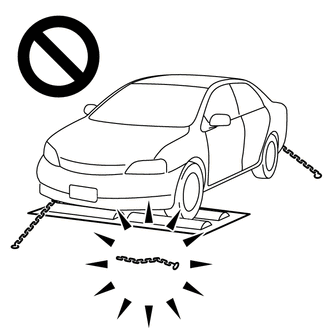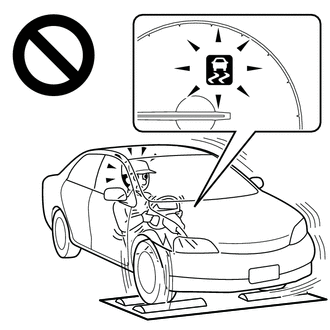PRECAUTION PRECAUTION FOR DISCONNECTING CABLE FROM NEGATIVE AUXILIARY BATTERY TERMINAL NOTICE: When
disconnecting the cable from the negative (-) auxiliary battery
terminal, initialize the following system(s) after the cable is
reconnected: System See Procedure Lane Departure Alert System (w/ Steering Control) Intelligent Clearance Sonar System Parking Assist Monitor System Panoramic View Monitor System Pre-collision System Lighting System (for HV Model with Cornering Light) TROUBLESHOOTING PRECAUTIONS (a)
When there is a malfunction with terminal contact points or part
installation problems, removal and installation of the suspected problem
parts may return the system to the normal condition either completely
or temporarily. (b) In order to determine the
malfunctioning area, be sure to check the conditions at the time the
malfunction occurred, such as DTC output and Freeze Frame Data, and
record it before disconnecting each connector or removing and installing
parts. (c) Since the system may be influenced by
malfunctions in systems other than the brake control system, be sure to
check for DTCs in other systems. HANDLING PRECAUTIONS (a)
Do not remove or install electronically controlled brake system parts
such as the steering angle sensor, yaw rate and acceleration sensor
(airbag ECU assembly) or brake pedal stroke sensor assembly except when
required, as they need to be adjusted correctly after removal and
installation. (b) Be sure to perform preparation
before work and confirmation after work is completed by following the
directions in the repair manual when working on the electronically
controlled brake system. (c) When
removing/installing or replacing an electronically controlled brake
system related component, disconnect the cable from the negative (-)
auxiliary battery terminal before performing the procedure. NOTICE: After
turning the power switch off, waiting time may be required before
disconnecting the cable from the negative (-) auxiliary battery
terminal. Therefore, make sure to read the disconnecting the cable from
the negative (-) auxiliary battery terminal notice before proceeding
with work. Click here (d)
If the skid control ECU (brake booster with master cylinder assembly),
brake booster pump assembly, brake actuator assembly or a sensor has
been removed and installed, it is necessary to check the system for
problems after the parts have been reassembled. Check for DTCs using the
Techstream. Also check that the system functions and signals received
by the ECU are normal using Test Mode (Signal Check). HINT: If
a Test Mode (Signal Check) inspection is not performed, a sensor not
calibrated malfunction DTC may be stored even if the skid control ECU
(brake booster with master cylinder assembly) and all sensors are
normal. (e) If the brake pedal is depressed before
the brake control system is prepared to operate, the pedal stroke may
seem unusually long or short. This is due to the fact the stroke
simulator cut solenoid has not yet operated and is not a malfunction. After
the power switch is turned on (IG) or the brake pedal is depressed
twice or more, the stroke simulator will operate and the brake pedal
stroke will remain consistent. DTC PRECAUTION (a)
Warnings for some DTCs cannot be cleared by only repairing the
malfunctioning parts. If the warning is displayed even after repair
work, the DTC should be cleared after turning the power switch off. NOTICE: If a DTC for a malfunctioning part reappears after it is cleared, then it has been stored again. (b) When 2 or more DTCs are detected, perform circuit inspections one by one until the problem is identified. CHASSIS DYNAMOMETER PRECAUTION (a) Enter Inspection Mode to disable TRAC and VSC operation when using a chassis dynamometer. Refer to Inspection Mode Procedure: Click here
CAUTION: DISABLING AND ENABLING OF TRAC AND VSC BY OPERATION OF VSC OFF SWITCH (a) Switching of mode Operating the VSC OFF switch switches the system between normal mode, TRAC off mode and VSC off mode. (1) Normal mode If the VSC OFF switch is pressed when in TRAC off mode or VSC off mode, the system enters normal mode. In normal mode, TRAC and VSC are enabled. The system is set to normal mode when the power switch is turned on (IG). (2) TRAC off mode If
the VSC OFF switch is pressed when in normal mode, the system enters
TRAC off mode. When in TRAC off mode, TRAC is disabled and the
multi-information display in the combination meter assembly displays
"Traction Control Turned Off". When the vehicle reaches a certain vehicle speed when in TRAC off mode, the system automatically returns to normal mode. (3) VSC off mode When
the VSC OFF switch is pressed and held for 3 seconds or more with the
vehicle stopped, the system enters VSC off mode. When in VSC off mode,
TRAC and VSC are disabled, the multi-information display in the
combination meter assembly displays "Traction Control Turned Off" and
the VSC OFF indicator light is illuminated. The system does not automatically return to normal mode based on vehicle speed when in VSC off mode. CAN COMMUNICATION SYSTEM PRECAUTIONS (a)
The CAN communication system is used for communication between the skid
control ECU (brake booster with master cylinder assembly), steering
angle sensor, yaw rate and acceleration sensor (airbag ECU assembly) and
other ECUs. If there is a malfunction in a CAN communication line,
corresponding DTCs for the communication line are output. (b)
If any CAN communication DTCs are output, repair the malfunction, then
troubleshoot the VSC system while communication is normal. (c)
In order to enable CAN communication, a specific type of wiring is used
for the CAN communication lines. The wiring used for each communication
line is a twisted pair of wires that have an equal length. A bypass
wire should not be used, because the data being transmitted will be
corrupted. PROBLEM SYMPTOMS TABLE If
there are no DTCs but the problem still occurs, check the suspected
areas for each problem symptom in the order given in the table below and
proceed to the relevant troubleshooting page. Symptom Suspected Area Link ABS warning light abnormal (Remains on) Refer to the procedure for "ABS Warning Light Remains ON" ABS warning light abnormal (Does not come on) Refer to the procedure for "ABS Warning Light does not Come ON" Brake warning light / red (malfunction) abnormal (Remains on) Refer to the procedure for "Brake Warning Light Remains ON" Brake warning light / red (malfunction) abnormal (Does not come on) Refer to the procedure for "Brake Warning Light does not Come ON" Brake warning light / yellow (minor malfunction) abnormal (Remains on) Refer to the procedure for "Brake Control Warning Light Remains ON" Brake warning light / yellow (minor malfunction) abnormal (Does not come on) Refer to the procedure for "Brake Control Warning Light does not Come ON" Brake hold standby indicator light abnormal Refer to the procedure for "Brake Hold Standby Indicator Light Circuit" Brake hold operated indicator light abnormal Refer to the procedure for "Brake Hold Operated Indicator Light Circuit" Slip indicator light abnormal (Remains on) Refer to the procedure for "Slip Indicator Light Remains ON" Slip indicator light abnormal (Does not come on) Refer to the procedure for "Slip Indicator Light does not Come ON" TRAC does not operate Refer to the procedure for "TRAC does not Operate" Excessive brake pedal travel (No fluid leaks and no air in system) Refer to the procedure for "Excessive Brake Pedal Travel (No Fluid Leaks and No Air in System)" ABS does not operate Refer to the procedure for "ABS does not Operate" ABS operates before necessary when braking Refer to the procedure for "ABS Operates Before Necessary When Braking" VSC does not operate or VSC does not operate correctly Refer to the procedure for "VSC does not Operate or VSC does not Operate Correctly" Abnormal brake pedal response on first depression Refer to the procedure for "Abnormal Brake Pedal Response on First Depression" Brake actuator operation sound is loud during initial check Refer to the procedure for "Brake Actuator Operation Sound is Loud during Initial Check" VSC OFF switch abnormal Refer to the procedure for "VSC OFF Switch Circuit" Meter buzzer abnormal Refer to Meter / Gauge system Abnormal Noise is Heard from the Engine Compartment when Depressing the Brake Pedal Refer to the procedure for "Abnormal Noise is Heard from the Engine Compartment when Depressing the Brake Pedal" DESCRIPTION The skid
control ECU (brake booster with master cylinder assembly) is connected
to the combination meter assembly via CAN communication. CAUTION / NOTICE / HINT NOTICE: After
replacing the skid control ECU (brake booster with master cylinder
assembly), perform linear solenoid valve offset learning, ABS holding
solenoid valve learning, yaw rate and acceleration sensor zero point
calibration and system information memorization after performing "Reset
Memory". Click here PROCEDURE 1. CHECK CAN COMMUNICATION SYSTEM (a) Check if CAN communication system DTCs are output. Click here Result Proceed to DTCs are not output. A DTCs are output. B INSPECT CAN COMMUNICATION SYSTEM 2. PERFORM ACTIVE TEST USING TECHSTREAM (SLIP INDICATOR LIGHT) (a) Select the Active Test on the Techstream. Click here
Tester Display Measurement Item Control Range Diagnostic Note Slip Indicator Light Slip indicator light Indicator light ON/OFF Observe combination meter assembly Tester Display Measurement Item Range Normal Condition Diagnostic Note Slip Indicator Light Slip indicator light ON or OFF ON: Indicator light on OFF: Indicator light off - Active Test Display Slip Indicator Light Data List Display Slip Indicator Light (b) Check the operating condition of the slip indicator light when operating it using the Techstream. Result Proceed to Slip indicator light in the Data List does not change using the Active Test. A Slip indicator light in the Data List turns ON/OFF using the Active Test. B REPLACE BRAKE BOOSTER WITH MASTER CYLINDER ASSEMBLY 3. INSPECT COMBINATION METER ASSEMBLY (a) Perform the Active Test of the combination meter assembly (meter CPU) using the Techstream. Click here Tester Display Slip Warning (b) Check that the slip indicator light turns on or off in accordance with the Active Test. OK: The slip indicator light turns on or off in accordance with Techstream operation. REPLACE BRAKE BOOSTER WITH MASTER CYLINDER ASSEMBLY INSPECT METER / GAUGE SYSTEM Precaution





Problem Symptoms Table




















Slip Indicator Light does not Come ON


B

A


Chassis > ABS/VSC/TRAC > Data List
Chassis > ABS/VSC/TRAC > Active Test
A

B


OK

NG

Toyota Avalon (XX50) 2019-2022 Service & Repair Manual > Smart Key System(for Start Function, Gasoline Model): Security Indicator Light Does not Blink. Steering Lock does not Lock. System Diagram
Security Indicator Light Does not Blink DESCRIPTION The certification ECU (smart key ECU assembly) blinks the security indicator light (radio and display receiver assembly) when the immobiliser is set (engine switch off). The certification ECU (smart key ECU assembly) receives the security indicator ...